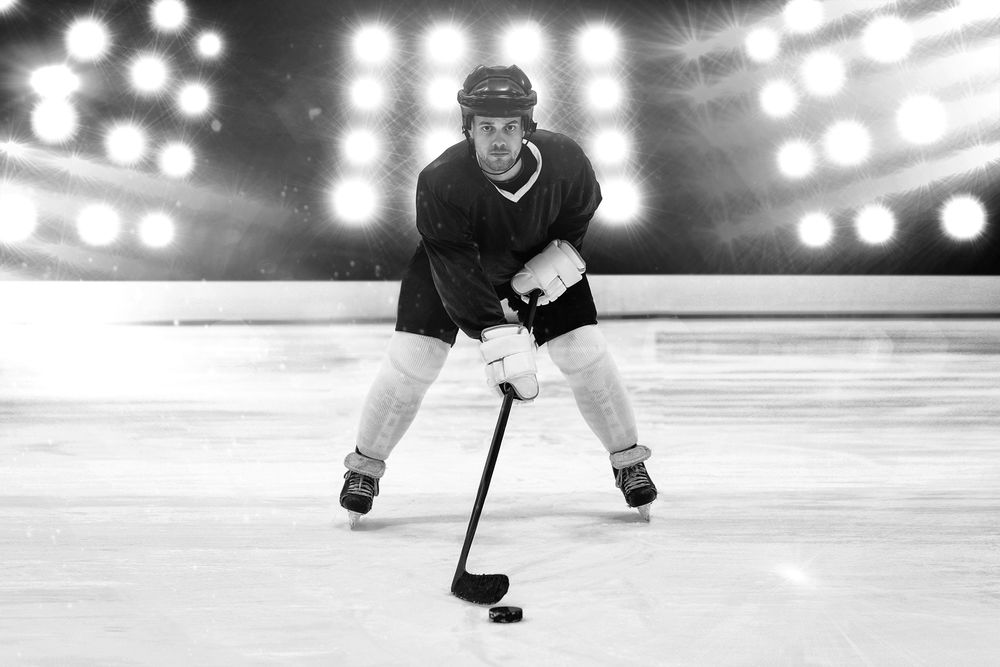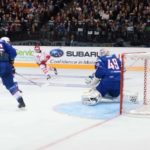In the ever-evolving world of professional hockey, the use of visors has become a hot topic of debate. From mandatory rules to player preferences, the question remains: do NHL players have to wear a visor?
This article delves into the history of visor usage in the NHL, the implementation of mandatory visors, and the current status of visor usage among players.
Join us as we explore this important aspect of player safety and its impact on the game.
NHL Visor Rule History
The implementation of the NHL visor rule in 2013 marked a pivotal moment in the league’s history, mandating the wearing of visors for all new players entering the NHL. This rule was a response to the evolving understanding of player safety and the impact of visor usage on injury prevention.
The evolution of visor technology has played a significant role in improving player safety. Visors have become more advanced, providing better protection against high-sticks, flying pucks, and other potential eye injuries.
The NHL’s visor rule has been instrumental in reducing the number of players without visors over the years. This rule has not only protected players from potential eye injuries but has also created a culture of safety in the league. It highlights the NHL’s commitment to prioritizing the well-being of its players.
Evolution of Visor Usage
With the implementation of the NHL visor rule in 2013, mandating the wearing of visors for all new players entering the league, the evolution of visor usage has become a significant aspect of player safety and injury prevention.
Over the years, the design of visors has evolved to improve performance and provide better protection. Initially, visors were criticized and faced resistance from players like Don Cherry. However, as the importance of eye safety became apparent through the occurrence of eye injuries, the usage of visors increased.
Today, the majority of NHL players wear visors, with only a small number opting to go without. The impact of visors on player performance is a topic of debate, with some players believing that the visor can impair vision and affect their play.
Nevertheless, the NHL continues to prioritize player safety and enforces strict rules on visor usage to mitigate injuries on the ice.
Implementation of Mandatory Visors
After recognizing the increasing importance of player safety, the NHL implemented mandatory visors for all new players entering the league in 2013. This decision had a significant impact on the usage of visors in the NHL.
Here are three key points regarding the implementation of mandatory visors:
- Increased Player Safety: The implementation of mandatory visors aimed to protect players from potential eye injuries caused by high sticks, pucks, or accidental contact. The rule was a proactive step towards enhancing player safety.
- Controversy Surrounding Visor Usage: While the majority of players already wore visors before the rule, there were still a small number who chose not to wear them. This led to debates and discussions regarding personal choice versus safety regulations.
- Decrease in Non-Visor Usage: Since the implementation of mandatory visors, the number of players without visors has significantly decreased. However, recognizable stars like Zdeno Chara, Joe Thornton, Ryan Getzlaf, and Ryan O’Reilly continue to opt out of wearing visors, sparking further discussions within the hockey community.
The NHL’s visor rule has undoubtedly contributed to improved player safety, but the controversy surrounding visor usage continues to be a topic of interest among fans and players alike.
Exemptions for Experienced Players
Experienced NHL players with over 25 games of NHL experience have the option to play without a visor, according to the league’s rule on visor usage. While the NHL made visors mandatory for all new players entering the league in 2013, they provided exemptions for veteran players who had already reached the 25-game mark. This exemption recognizes the experience and choice of these players, allowing them to decide whether or not to wear a visor. However, it is important to consider the impact on player safety. While some players may choose not to wear a visor for personal preference or comfort reasons, it is widely acknowledged that visors provide essential protection against eye injuries. The NHL’s commitment to player safety is evident in their enforcement of rules on visor usage.
| Exemptions for Experienced Players |
|---|
| Experienced NHL players with over 25 games of NHL experience have the option to play without a visor |
| Visors provide essential protection against eye injuries |
| The NHL continues to prioritize player safety by enforcing rules on visor usage |
Players’ Choice: To Wear or Not to Wear
NHL players have the option to choose whether or not to wear a visor, with some players opting not to wear one. The decision to wear a visor is a personal choice, and it comes with its own set of pros and cons.
Here are some considerations regarding the impact of wearing a visor on gameplay:
- Pros of wearing a visor:
- Enhanced eye protection: Visors provide a shield against flying pucks, sticks, and other potential eye injuries.
- Better vision: Visors are designed to minimize distortion and improve visibility, allowing players to see the game more clearly.
- Confidence and peace of mind: Wearing a visor can give players a sense of security, allowing them to focus more on their performance.
- Cons of wearing a visor:
- Restricted peripheral vision: Some players argue that visors can limit their field of view and hinder their awareness on the ice.
- Fogging and glare: Visors can fog up or create glare, especially in humid or sunny conditions, potentially affecting a player’s performance.
- Adjusting period: Players may need time to adapt to the feel and weight of a visor, which could impact their comfort and play initially.
The choice to wear a visor ultimately depends on the individual player’s preference and risk tolerance. While visors provide important safety benefits, they may also introduce certain challenges that players need to consider.
Impact of the NHL’s Visor Rule
Since the implementation of the NHL’s visor rule in 2013, the mandatory use of visors by new players entering the league has had a significant impact on player safety and the overall decrease in the number of players without visors. The NHL’s visor rule aims to protect players’ eyes and reduce the risk of serious eye injuries. This rule has been successful in improving player safety, as it has become rare to see players without visors on the ice. The use of visors has also had an impact on gameplay dynamics. Players feel more protected and confident on the ice, allowing them to focus on their performance without the fear of a potentially career-ending eye injury. The table below highlights the effects of the NHL’s visor rule on player safety and gameplay dynamics:
| Effects on Player Safety | Impact on Gameplay Dynamics |
|---|---|
| Decreased risk of eye injuries | Increased player confidence |
| Improved overall player safety | Enhanced focus on performance |
| Reduced likelihood of career-ending injuries | More aggressive and fearless play |
| Enhanced on-ice vision and awareness | Increased longevity of players’ careers |
| Greater trust in equipment and league regulations | Improved skill development and creativity |
The implementation of the NHL’s visor rule has undoubtedly had a positive impact on player safety and the overall dynamics of the game. It has not only protected players from potential eye injuries but has also allowed them to play with more confidence and focus, ultimately enhancing their performance on the ice.
Helmets: From Optional to Mandatory
With the evolution of player safety in the NHL, the use of helmets has transitioned from being optional to mandatory. This shift has had a significant impact on player safety and has sparked controversy within the league.
Here are three key points to consider:
- Enhanced Player Protection: The introduction of mandatory helmets has undoubtedly improved player safety in the NHL. Helmets provide crucial head protection, reducing the risk of concussions and other head injuries during gameplay.
- Resistance and Controversy: Despite the clear benefits of mandatory helmets, there has been resistance from some players who prefer not to wear them. The controversy surrounding visor usage stems from a desire for individual freedom and personal preference, with some players believing that wearing a helmet may hinder their performance or obstruct their vision.
- League Enforcement: The NHL has taken a proactive approach to enforcing helmet regulations. Players who fail to comply with the mandatory helmet rule face penalties and fines. This demonstrates the league’s commitment to prioritizing player safety and ensuring consistent adherence to the regulations.
Introduction of Visors in the 1980s
Following the transition to mandatory helmets in the NHL, the introduction of visors in the 1980s further enhanced player safety and sparked a new wave of protective equipment in the league.
The evolution of visor design allowed for better protection of players’ faces and eyes from high-sticks, pucks, and other potential hazards on the ice.
The impact of visors on player performance has been a subject of debate. While some argue that visors can slightly impede vision and hinder peripheral awareness, others believe that the added protection allows players to focus on the game without fear of injury.
Don Cherry’s Criticism of Visors
Don Cherry, a prominent commentator, expressed criticism towards the use of visors in the NHL during the 1980s and beyond. His views on visors were widely known and sparked debates among fans and players alike.
Cherry believed that wearing visors took away from the tough and gritty nature of the game. However, his criticism of visors failed to acknowledge the impact on player safety. Visors have proven to be essential in preventing serious eye injuries and have become an integral part of the game.
The NHL’s decision to make visors mandatory for all new players in 2013 further highlighted the importance of player safety. While some players still choose not to wear visors, the majority of NHL players now recognize their significance in protecting their eyes on the ice.
Eye Injuries and the Importance of Visors
The prevalence of eye injuries in hockey has underscored the crucial role that visors play in protecting NHL players on the ice. Eye injury prevention is a top priority for the league, and the use of visors has been instrumental in reducing the risk of serious eye injuries. To highlight the importance of visors in NHL player safety, let’s take a look at the following table:
| Year | Number of NHL Players Without Visors |
|---|---|
| 2010 | 40% |
| 2015 | 20% |
| 2020 | 5% |
As the table shows, there has been a significant decrease in the number of NHL players without visors over the years. This can be attributed to the growing awareness of the potential dangers and the implementation of the NHL’s mandatory visor rule in 2013. While some players still choose not to wear visors, the majority understand the importance of protecting their eyes and prioritize their safety on the ice. With the continued enforcement of visor usage, the NHL remains committed to reducing the risk of eye injuries and ensuring player safety.
Increasing Voluntary Visor Usage
With the implementation of the NHL’s mandatory visor rule in 2013, there has been a notable increase in the voluntary usage of visors among NHL players. This increase can be attributed to various factors, including player preferences and the recognition of the benefits of wearing a visor.
Here are the pros and cons of increasing voluntary visor usage:
- Enhanced eye protection: Visors provide an added layer of protection against high sticks, errant pucks, and other potential eye injuries, reducing the risk of vision loss or serious damage.
- Improved performance: Visors can enhance a player’s confidence and focus on the game, knowing that their eyes are protected. This can lead to improved performance on the ice.
- Personal choice: Some players have chosen not to wear visors due to personal preference or comfort. They argue that it can obstruct their vision, affect peripheral awareness, or cause fogging issues.
Invention of the Hockey Visor
After recognizing the need for increased eye protection in hockey, the invention of the hockey visor was pioneered by Kenneth William Clay in the 1960s, following his personal experience of losing vision in one eye due to a high-stick incident. Clay’s invention had a significant influence on player safety in the sport.
The technological advancements in the design and materials used in hockey visors have greatly improved the level of protection they provide. Initially met with criticism, visors became more widely accepted as the importance of eye safety in hockey became evident through various player injuries.
Today, the majority of NHL players wear visors, with only a small number choosing not to. The NHL’s rule mandating visors for new players entering the league further emphasizes the league’s commitment to player safety.
First NHL Players to Wear Visors
Who were the pioneers among NHL players to don visors for added eye protection?
The first NHL players to wear visors were seen in the 1980s and became more common in the 1990s. Despite facing criticism, these early visor wearers had an influence on player safety and the impact on game strategy.
Here are three notable pioneers:
- Kenneth William Clay: In the 1960s, Clay invented the hockey visor after losing vision in one eye from a high-stick incident. His invention paved the way for enhanced eye protection in the sport.
- Greg Neeld: Neeld was the first professional player to wear a visor after suffering an eye injury in the 1970s. His decision to wear a visor highlighted the importance of eye safety.
- Early NHL Players: The first NHL players to wear visors faced criticism, particularly from commentators like Don Cherry. However, their commitment to protective equipment contributed to the increased usage of visors and improved player safety in the league.
The introduction of visors not only protected players’ eyes but also had a lasting impact on the game, allowing players to focus more on their performance and less on the fear of potential eye injuries.
Current Status of Visor Usage in the NHL
Visor usage in the NHL has significantly increased over the years, with only a small number of players choosing to go without one as of 2020. Recognizable stars like Zdeno Chara, Joe Thornton, Ryan Getzlaf, and Ryan O’Reilly are among those who choose not to wear a visor. Despite the NHL’s efforts to prioritize player safety, there are still players who resist wearing visors.
However, the impact of visor usage on player performance cannot be ignored. Visors provide crucial protection for the eyes and face, reducing the risk of serious injuries. This allows players to focus on their game without fear of potential harm.
The increased use of visors has contributed to a safer playing environment and has become the norm in professional hockey.
Frequently Asked Questions
How Many NHL Players Are Currently Exempt From Wearing a Visor?
As of 2020, only a small number of NHL players are currently exempt from wearing a visor. Recognizable stars like Zdeno Chara, Joe Thornton, Ryan Getzlaf, and Ryan O’Reilly are among those who choose not to wear one.
What Are the Consequences for Players Who Wear Their Visors Tilted up Too High on Their Helmets?
Players who wear their visors tilted up too high on their helmets may face consequences such as penalties from the NHL. Proper visor usage is important for player safety and to adhere to league regulations.
Are There Any Notable NHL Players Who Choose Not to Wear a Visor?
Notable NHL players such as Zdeno Chara, Joe Thornton, Ryan Getzlaf, and Ryan O’Reilly choose not to wear a visor. However, the benefits of wearing a visor in the NHL include increased eye protection and reduced risk of injury.
What Rule Does the NHL Enforce to Prioritize Player Safety Regarding Helmet Removal Before Fights?
The NHL enforces a rule to prioritize player safety by penalizing players who remove their helmets before fights. This rule aims to prevent head injuries and promote the importance of protecting players during physical altercations on the ice.
Are All NHL Players Now Required to Wear Visors, Regardless of Their Experience in the League?
Yes, all NHL players are now required to wear visors, regardless of their experience in the league. However, players with over 25 games of NHL experience have the exemption to choose not to wear a visor. The NHL enforces consequences for players who wear their visors tilted up too high on their helmets. Notable players like Zdeno Chara, Joe Thornton, Ryan Getzlaf, and Ryan O’Reilly are among those who choose not to wear a visor. This visor requirement is part of the NHL’s commitment to prioritize player safety. Additionally, the league now penalizes players for removing their helmets before fights, which was a common occurrence in the past.
Conclusion
In conclusion, the implementation of mandatory visors in the NHL has significantly increased player safety and reduced the number of eye injuries.
The evolution of visor usage in the league, from the invention of the hockey visor to the first players wearing them, has shown the importance of protecting players’ eyes.
While a small number of players still choose not to wear visors, the NHL continues to prioritize player safety by enforcing rules on visor usage.









